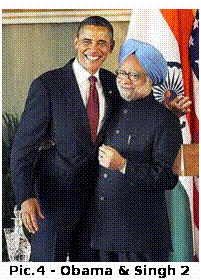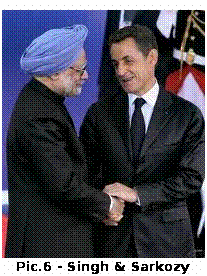The Tales That Pictures Tell: Body Language In Strategy And Negotiations
By S.G.Vombatkere
01 September, 2013
Countercurrents.org






Communication
Animals communicate within and outside their species by making sounds, but largely by signals made with parts of their bodies. Humans have refined communication and expanded its scope manifold through the use of spoken and later written language, but still use body language to communicate consciously or unconsciously. Desmond Morris, in his seminal books “The Naked Ape” , “The Human Zoo” and “Manwatching” , explains behaviour and body language in general and in “Manwatching” , human body language in particular.
The position and movements of the arms and hands, slant of the head, tilt of chin, facial expression, etc., together convey the attitude and approach of an individual. These are of course dependent upon the people who are interacting (sex, physical size, age, social status, etc.) and the circumstance (place, purpose or its absence, time, etc) of their meeting and interaction. In fact all people use body language, mostly unconsciously, in routine daily activities, in public spaces, at social events and on particular occasions. The state of mind (for example, confidence due to superior position, status, knowledge, etc), the body language and speech (content and delivery – what is spoken and how it is spoken) affect each other. These go to make “the person” who “presents” himself/herself at any place, whether in the home, in the marketplace, the social event, workplace or public space, while interacting with other individuals or groups. Thus, even before words are spoken, body language introduces the inter-personal contact. Experienced negotiators employ body language deliberately to gain a superior position in negotiations.
National leaders
When leaders or people vested with authority and responsibility at any level meet, their body language is nuanced. The nuance would depend upon the purpose of the meeting and the relative position with respect to the agenda, and of the leader-as-a-person presenting himself/herself before the opposite party. His/her body language is important at the start and the duration of the meeting because it is one of the important determinants of the direction in which the meeting proceeds, the note on which it concludes, and its outcome.
One of the attributes of leadership is being able to show self-control and situation-control through body language and speech. Meetings between leaders are meant to discuss or negotiate issues affecting the leaders and their countries, and the outcome of such meetings have huge political and economic importance that can affect not only the countries represented but also other countries, and even the international scene.
Body language between leaders
An example of the importance given to body language in meetings of national leaders is a media report with a picture of Obama and Putin [Pic.1] . After the meeting, Obama is quoted as saying, “ I know the press likes to focus on body language and he's got that type of slouch, looking like the bored kid in the back of the classroom ”. These words spoken after the meeting, might indicate Obama's attempted superiority over Putin, but it must be viewed in light of Putin granting U.S citizen Edward Snowden temporary asylum in Russia after USA demanded that he be extradited to USA. The body language in interpersonal relations between these two powerful leaders, obviously taken together with what was spoken and left unspoken, had its effect on the outcome of their meeting.
It is interesting to go back a few years to pictures of cordial meetings between India's Prime Minister Dr.Manmohan Singh, with successive U.S presidents George W. Bush and Barack Obama. These pictures immediately indicate unexceptionable personal friendliness, but with shades of relative status. In Pic.2 & Pic.3 , the U.S president has his hand on the base of the Indian PM's neck, in a patronizing manner. Even though the pictures were taken years apart, the position of different U.S presidents' hands on Singh's neck is identical. In Pic.4, Obama is seen as patting Singh on his shoulder. The video from which Pic.4 is a still, actually shows the patting action. Obama can be observed leaning towards Singh, with Singh leaning backward at the waist, slightly off-balance. Singh's right hand is around Obama's waist, as much a sign of reciprocal cordiality as it is to retain balance. Obama's patting action is in the manner of a superior expressing approval to a subordinate person, not unlike a father to a son or a patron to a ward. Singh's body language (and even his facial expression, though this is prone to mis-reading) bears the mark of being grateful for the approval. The body language in these pictures speaks of the personality-dominance of Bush and Obama, both clearly masters of body language, and the dominated or subordinate position of Singh.
In the pictures of Singh with Musharraf, then President of Pakistan, and with Sarkozy, then President of France, there is obvious cordiality between the leaders. Singh's body language speaks of confidence, which is at sharp variance in Singh with the U.S presidents.
Politics
In the present inter-connected “global village”, economics drives and dictates politics. Thus the reason for meetings between national leaders is most often to do with economics. But such meetings inevitably have a political background, a political objective and a political result that may transcend the territorial boundaries of their nations.
Referring to the pictures under discussion, Pic.2 was taken when the Bush government had prepared the so-called 123 Agreement for civilian nuclear cooperation with India, primarily to revive the moribund U.S nuclear industry. This agreement was part of the USA-India strategic cooperation framework. The nuclear deal was over-shadowed by the provisions of the Hyde Act, an India-specific legislation that visualizes India having a foreign policy “congruent with” that of USA. Singh as PM, had even staked his UPA-1 government to ensure that the 123 Agreement went through. His picture with Bush precedes his remark, criticised in India, that “India loves Bush”.
Pic.3 and Pic.4 of Obama and Singh pertain to the much closer economic ties between USA and India in pursuance of the U.S policy, the foundations of which were laid by Bush's Republican government and continued by Obama. The meeting concerned FDI into India, opening the retail trade market, easing introduction of GM crops, and other bilateral economic issues.
The strategic partnership between USA and India is admittedly unequal, with India being the junior partner. The body language of the Indian and U.S leaders clearly depicts this asymmetry, but whether it is the cause or the result of strategic assymetry is a matter for conjecture.
Pictures of Singh with Musharraf and with Sarkozy have their own political overtones. India's superior economic-political-military position with respect to Pakistan is reflected in Singh's confident stance with Musharraf. Singh's confident stance with Sarkozy is related with France needing to get business with India in selling their nuclear hardware for the world's biggest nuclear park at Jaitapur in Maharashtra.
Tail piece - tales in pictures
Body language can complement and supplement spoken words. When the spoken words are unknown as in most meetings at high levels, interpreting the body language of leaders in media pictures, can be interesting and informative.
Major General S.G. Vombatkere retired as the Additional Director General, Discipline & Vigilance in Army HQ, New Delhi. The President of India awarded him the Visishta Seva Medal in 1993 for distinguished service rendered over 5 years in Ladakh. He holds a PhD degree in Structural Dynamics from IIT, Madras. He is Adjunct Associate Professor of the University of Iowa, USA, and is a member of NAPM and PUCL. He writes on strategic and development-related issues. E-mail: <[email protected]>
Comments are moderated

